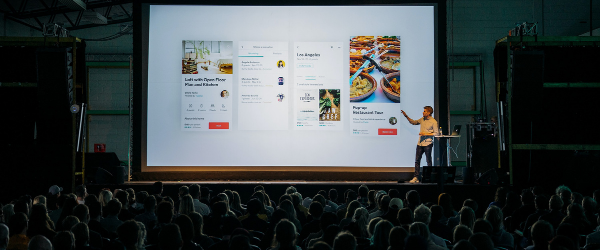Memorable ways to open a speech

The ability to communicate can propel a leader to greatness. Speeches and speaking engagements are an integral way to make your mark and to effectively communicate your ideas and vision. CEOs and other leaders are influencers, and these performative moments can make for lasting impacts. But be careful – your audience will be quick to apply judgment on your speech, from the very first few moments of your presentation. A strong introduction will provide attention and a connection with your audience. The first few moments, not minutes, of your speech, will be vital. You want to build a rapport and be sure to hook the audience and keep them riveted.
Performance is key!
Before we delve into some opening techniques, it is important that as a speaker, you realize that you are giving a “performance” and that your physical presence is as vital to the success of your speech as are the words being spoken. You want to immediately command the room, own the stage, and state your position as a confident presenter. Stage presence will lend authenticity to your words.
But be aware that this is where nerves can hinder a presenter, so it is key to know your own strengths, as well as limitations. You need to find the speaking manner that is most comfortable to you and provides you with self-assurance, which will in turn, influence the audience’s confidence in you.
Remember – body language affects the quality of the speech.
Brevity
In regard to your speech, it is often helpful to remember that directness and clarity will lead to a more memorable speech. Speaking in short, clipped sentences imparts a sense of urgency and a sense of speed and passion. Short speeches can often be the most powerful, and quite often, trying to convey too much in one presentation can lose an audience. A succinct message is usually a memorable one. Keep in mind the average adult can keep their attention focused for roughly 20 minutes.
Setting the stage
Before delivering a speech, it may be worth taking a few moments of silence or an extra-long pause before beginning, as this allows the audience the chance to settle down and also brings all the attention forward to the stage and onto you!
Some opening techniques to consider:
1) Storytelling: A personal story, experience or anecdote
Just delivering information can be boring and can disconnect you from the audience.
Facts, data, concepts, etc. can often get lost in the spoken presentation and stories are easier to tell, and easier to connect. Telling a story can be a technique that highlights your commitment to the company and the staff and the message you are trying to impart. It also lends itself to establishing a common ground with your audience. The personal touch also brings the audience closer to you, and they will feel more connected to you. An audience is also more likely to remember your speech and even quote from it, if it has its origins in a story.
A story can also help with nerves, as presenting material you know well and are comfortable detailing, gives you the chance to be in the moment as opposed to delivering a canned speech. Just try to avoid overused openings such as “I’d like to begin with a story”, and instead start with the action. Set the tone for your presentation and become a storyteller.
“The most powerful person in the world is the storyteller” – Steve Jobs
2) Question
Instead of starting with a bland statement such as “Thanks for having me /”Nice to be here”/ “Thanks for that intro”, set the tone by starting with a provocative, evocative or compelling question.
A question immediately engages the audience. This brings the audience to start thinking in line of your presentation, while also including them in your speech. Starting with the likes of “Have you ever wondered…?”, “Do you worry…?” will have people intuitively answering your questions while waiting for your answers.
“How do you explain why some people are able to achieve things that seem impossible?” – Simon Sinek
3) Humor
If you are confident you can stick the landing, humor is a great way to start a speech. It can be something about yourself, the audience etc. that can then lead into the main part of your speech. The humor can be light-hearted, an amusing anecdote and work as a way to engage your audience.
A self-effacing joke is often attractive to an audience, who will appreciate the modesty and humility it shows. But do tread the line carefully, as you also do not want to come off as self-pitying or makes jokes that diminish your credibility and the speech.
How many people have never raised their hand before? – Steve Martin
4) Startling, powerful or provocative statement
Immediately the audience wants to know more about what you are going to say. The audience is intrigued, and you have their full attention.
Sadly, in the next 18 minutes when I do our chat, four Americans that are alive will be dead from the food that they eat. – Jamie Oliver
5) Statistic
This does not have to be a company statistic per se, but a statistic that grabs attention and can tie into your speech, in other words, relate your statistic to your audience and your speech.
“There have been many revolutions over the last century, but perhaps none as significant as the longevity revolution. We are living on average today 34 years longer than our great-grandparents did. Think about that: that’s an entire second adult lifetime that’s been added to our lifespan.” – Jane Fonda
6) Quotation
Get creative with your quotes and make sure it is the ideal quote for your speech. Don’t use an overused quote but find something that moves you. A powerful quote will reinforce your message and boost your point.
The common question that gets asked in business is, ‘why?’ That’s a good question, but an equally valid question is, ‘why not?’ – Jeff Bezos
7) Today in History/Current Affairs
Find something that is relevant to your subject matter and use it to segue into your speech. For example, if it is something current, you can even use a newspaper as a prop to back up your opening reference. An internet search can provide you with options both historical and current.
“I speak to you for the first time as Prime Minister in a solemn hour for the life of our country, of our empire, of our allies, and, above all, of the cause of Freedom.” – Winston Churchill
8) Physical Prop, a Visual or Audio Effect
Usually, an audience is not expecting props, especially something out of the ordinary, so when a speaker uses this option, it immediately grabs everyone’s attention. Props are concrete examples that also bring drama to your presentation.
A famous example is when Bill Gates was giving a TED Talk on mosquitos and malaria and actually released some mosquitos into the audience. This was a bold move yet tied in completely to his presentation, bringing a concrete and emotional addition to his words and made this presentation one that is still referenced 10 years later.
Now, malaria is of course transmitted by mosquitos. I brought some here, just so you could experience this. We’ll let those roam around the auditorium a little bit. There’s no reason only poor people should have the experience. Those mosquitos are not infected.” – Bill Gates
9) Evoking an Image
Use your audience and their imaginations by having them picture something you want them to see. This immediately draws your audience in and engages them in a group activity that will have them comparing notes at the end of your speech.
“Please close your eyes and open your hands. Now imagine what you could place in your hands: an apple, maybe your wallet. Now open your eyes. What about a life?” – Jane Chen
10) Be Authentic
If you can be candid and tell a revealing story, you will draw the audience in and build an emotional connection.
“I’m going to tell you a little bit about my TEDxHouston Talk. I woke up the morning after I gave that talk with the worst vulnerability hangover of my life. And I actually didn’t leave my house for about three days.” – Brene Brown
At Executive Forums, we are a global community of business & thought leaders evolving together through the power of collective intelligence. Access to best practices, opportunities, and ideas from business leaders around the world.
Thanks for reading!














